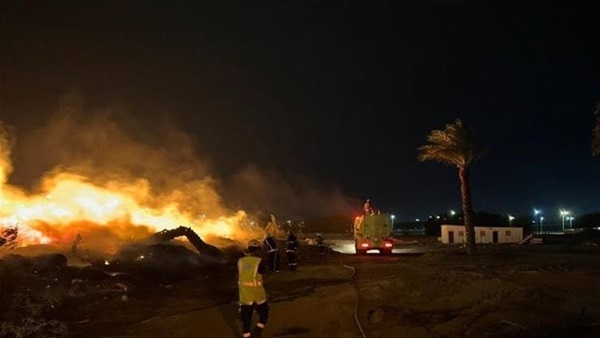Fire Erupts at Iran’s Most Notorious Prison Amid National Protests

A massive fire broke out on Saturday at Evin prison, the notorious detention facility in Iran’s capital where hundreds of dissidents and political prisoners are held, as anti-regime protests roiled the country for a fifth week. As the fire raged, the sounds of explosions and gunfire could be heard in the neighborhood near the prison, according to witnesses and videos posted to social media.
IRNA, the state news agency, reported that eight people had been injured in the fire, which it said started during clashes in a wing of the prison that housed those convicted of financial crimes.
Four “massive explosions” were heard after IRNA reported that the fire had been extinguished, according to Fars News Agency, an official outfit affiliated with the Revolutionary Guards.
It is unclear how the fire began or the extent of the damage. Contradictory reports on social media cited an explosive device, an attempted escape and an infiltration of the prison from the outside.
Among the thousands of prisoners at Evin are hundreds of dissidents, including prominent opposition politicians, activists, lawyers, journalists, environmentalists and students. The prison, which was built in Tehran seven years before the 1979 Islamic Revolution that supplanted the country’s monarchy with a theocratic republic, was the subject of American sanctions for what the United States government described as “serious human rights abuses.”
Sections of the facility are run by Iran’s intelligence services and Revolutionary Guard Corp, and it is infamous for accusations of torture and a potent symbol of the regime’s authoritarian approach to justice.
Among those held at the prison are two American businessmen, Siamak Namazi and Emad Sharghi. Both men are dual Iranian nationals who have been accused of spying. Also imprisoned there are the reformist politicians Mostafa Tajzadeh and Faezeh Hashemi, as well as the prominent human rights activist Narges Mohammadi, and Jafar Panahi, an internationally renowned film director.
Ned Price, a spokesman for the U.S. State Department, said on Twitter that “Iran is fully responsible for the safety of our wrongfully detained citizens, who should be released immediately.”
The prison sits on a hilltop at the foot of the Alborz Mountains, which surround Tehran. The compound is surrounded by electric barbed-wire fences and a minefield. Around the prison is the Evin District, a leafy upscale residential neighborhood known for its gardens and villas.
A resident of the district, whose home abuts the prison, said she could see several buildings in the prison compound on fire and that she had heard screams coming from inside. Speaking on the condition of anonymity for fear of reprisal, she said she had heard gunshots beginning at 10 a.m. on Saturday. By 9 p.m., she said, she could hear the sounds of automatic gunfire, followed by enormous explosions.
The woman said the windows of many nearby homes had been shattered by the blasts and that locals could be heard shouting “death to the dictator.”
Well into the early hours of Sunday morning, and after the fires had been reportedly extinguished, residents continued to report hearing additional blasts.
Internet and telephone communications have been severely disrupted in Iran since anti-government protests erupted last month. On Saturday, the judiciary ordered telecom companies to ban text-messaging services, further limiting the ability of Iranians to communicate.
Saturday’s conflagration, the first at the prison in recent memory, occurred against the backdrop of nationwide protests that began in September after Mahsa Amini, 22, died while in the custody of the morality police. Ms. Amini was accused of improperly wearing a required head scarf, a violation of the law in the Islamic Republic.
Iranians, already on edge after more than a month of protests, said the fire at the prison had only increased their anxieties. The families of detainees said they feared not only for the safety of their loved ones, but also for themselves.
Human rights activists and organizations also expressed concern about the safety of the prisoners.
“Prisoners, including countless political prisoners, are completely defenseless inside that prison,” Hadi Ghaemi, the executive director of the Center for Human Rights in Iran, said in a statement.
Speaking on Saturday, in a live chat on the social media app Clubhouse, Yasser Hashemi Rafsanjani, the youngest son of the former president, Akbar Hashemi Rafsanjani, said: “Unfortunately, we are seeing the state — despite its claim that it has security under control, if not the economy and other things — is not fully capable of managing it.”
Both Mr. Hashemi Rafsanjani’s sister Faezeh and his brother Mehdi are imprisoned at Evin.
Hundreds of officers from different branches of the military and security forces, including the Basij, a feared plainclothes militia, were deployed to the prison. Residents of the Evin neighborhood said the air around the prison was thick with ash, smoke and tear gas.
“It felt like we were watching a war movie,” said Amirdaryoush Youhaei, a 22-year-old university student who lives in the neighborhood. “There was a massive siren and then 11 big explosions and machine gunfire that didn’t stop.”
On Saturday, protests continued in Tehran and other cities across the country, with crowds chanting “death to the dictator.” In videos posted on social media, security forces were seen violently beating and arresting protesters. In the northwest city of Ardabil, protesters clashed with security officers after reports that officers had raided a high school on Friday and had beaten students. Ten students were reportedly hospitalized, and one student is believed to have died, according to a statement from Iran’s Union of Educators.





